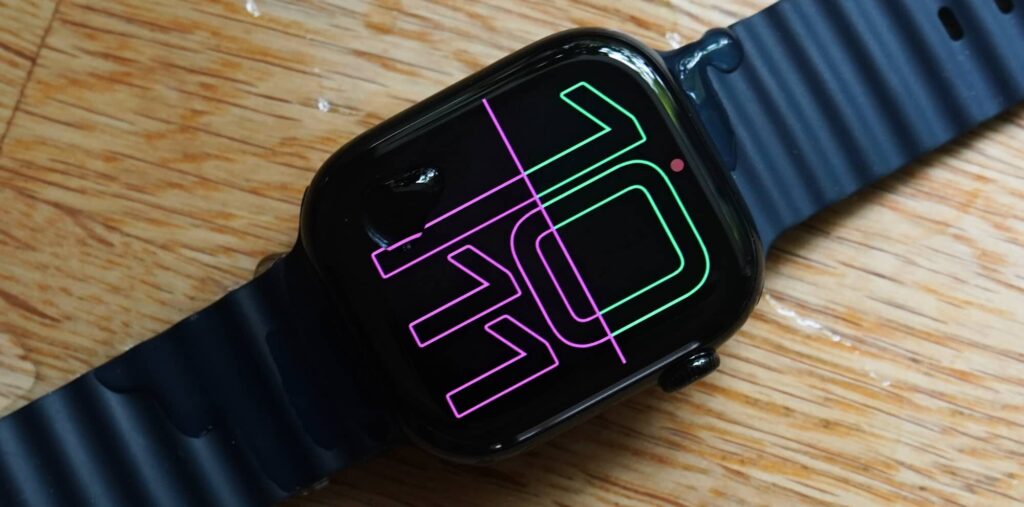Ten years since its inception, the Apple Watch continues to evolve, bringing a substantial screen overhaul and a sleek new design with its Series 10. But does this latest iteration justify an upgrade, or is it merely keeping up appearances?
In today’s tech-driven world, smartwatches are no longer just an extension of our smartphones—they’ve become central to our digital lives, championing health and convenience. The newest apple in Apple’s wearable orchard, the Series 10, is lighter, thinner, and boasts a larger screen. We dived deep into its features to see if it stands out in the ever-competitive smartwatch market.
A Design That Glimmers with Elegance
Apple has long been celebrated for its design prowess, and the Series 10 reinforces this reputation. The watch features a more refined, thinner profile with rounded corners that further enhance its sleekness. Polished titanium replaces stainless steel, while a glossy “Jet Black” aluminum finish, achieved through a meticulous 30-step process, adds a futuristic touch. Measuring 9.7mm in thickness, it’s a millimeter thinner than its predecessor, streamlining the device without compromising its durability.
The display has also received a significant upgrade, expanding to 46mm—a slight increase from the Series 7’s 45mm but notably larger than the Series 5’s 44mm. This brings almost 25 percent more screen real estate, which now curves gracefully over the edges, creating an illusion of an even larger display. While not quite as expansive as the 49mm Apple Watch Ultra, the Series 10’s bezel-less design makes it visually competitive.
Under the Hood: Familiar Yet Powerful
Underneath its polished exterior, the Series 10 carries over much of the hardware from the Series 9, with a few key updates. The new S10 chip ensures smooth performance, while an upgraded speaker enhances audio quality for music and podcasts. However, much of the internal sensor and connectivity technology remains unchanged from last year.
User Experience: Intuitive and Adaptive
The introduction of watchOS 11 with the Series 10 brings several new features and refinements. Users can choose between list and grid views for their apps, and a new watch face called “Flux” makes the most of the larger screen, dynamically changing colors to fill the display. Alongside Flux, a variety of analog and digital watch faces come complete with customizable complications to suit individual preferences.
Notably, the revamped widget system now prioritizes relevant information, dynamically displaying widgets based on context, such as weather updates based on location or music controls when you’re listening to tunes. Apple’s Translate app further enhances usability, allowing real-time translation directly from your wrist—a boon for travelers.
Adding to its versatility, the Series 10 inherits water depth detection from the more premium Watch Ultra models, automatically activating when you dive into water.
Health and Fitness: Comprehensive yet Familiar
The health features on the Series 10 remain largely consistent with previous models, offering heart rate monitoring, ECG, wrist temperature, and blood oxygen tracking, all available to Australian users. However, sleep apnea detection is still pending regulatory approval in Australia.
A new health app called Vitals consolidates key metrics such as heart rate, respiratory rate, temperature, and sleep tracking into a single, easily accessible interface, making it simpler for users to monitor their well-being.
Battery Life: A Familiar Constraint
One area where the Series 10 doesn’t make substantial strides is battery life. Like its predecessors, it offers roughly 24 hours of usage, necessitating daily charging. While the Series 10 benefits from faster charging speeds—reaching up to 80 percent in under 30 minutes—its battery life still falls short compared to the more robust Apple Watch Ultra 2.
Pricing and Value: Premium Comes at a Cost
Starting at $649 for the non-cellular aluminum model and rising to $809 for the cellular version, the Series 10 is not an inexpensive investment. The 46mm aluminum cellular model reviewed here costs $859, with the titanium versions starting at $1199. Given the absence of sapphire glass in the aluminum models, some may find the value proposition lacking compared to competitors like Samsung, which offers sapphire in standard models at similar price points.
Final Verdict: Evolution or Iteration?
For first-time buyers seeking a sophisticated and capable smartwatch, the Apple Watch Series 10 is an excellent choice. Its refined design, larger display, and improved software deliver a premium wearable experience.
However, for owners of recent models like the Series 9, the Series 10 may feel more like an aesthetic upgrade than a necessity. But for those with older Apple Watches, the Series 10 offers a compelling array of features and enhancements, making it worth the leap.
In summary, the Apple Watch Series 10 may not revolutionize the wearable landscape, but it certainly reinforces Apple’s position at the forefront. With its sleek design, expansive screen, and robust functionality, it stands as one of the best smartwatches money can buy—albeit with room for improvement in battery life and value for money. Recommended for newcomers and those looking to upgrade from an older model.


